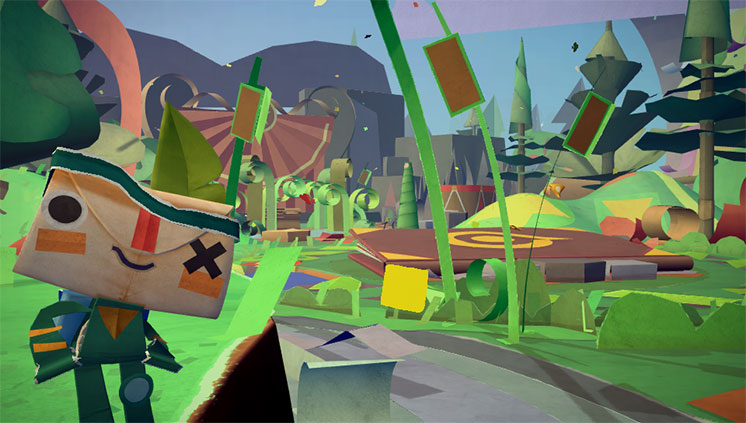By Jamaal Ryan
Tearaway has graced GOTY finalists for many, and even though
I didn’t play the Playstation Vita title last year from Media Molecule – the whimsical
masterminds behind the Little Big Planet franchise – it doesn’t earn a spot on
my 2013 list.
Tearaway is both an experiment in art design and hardware
capabilities. The paper-craftian world is delight to bathe one’s self in,
triggering the temptation of pondering on what will happen if you reach in. And
Tearaway fulfills that urge within the features of the Vita’s tactile design of
front and rear touch interfaces. Fingers pop up with a satisfying “punch”,
tight skins bounce with that tingling drum beat, and layers of the world peal
back in a satisfying way much like the Vita’s app interface does. I am not a
fan of altering my grip on devices and controllers in order to play a game,
however Tearaway’s aesthetic allows this to be aptly appropriate.
Tearaway will mean something do different styles of gamers,
and this divisiveness is quite stark at first. It takes a special sauce kind of
formula for me to even care about exploration. Games like Assassins Creed IV
did this effortlessly. And while there is incentivized exploration in Tearaway,
to me, it represented a last resort rather than in irresistible distraction.
What first got me to indulge in slipping my iota into the
creases and crevices of this constructed paper world was, quite frankly, I was
bored of the game and needed something else to do. Tearaway was essentially
shifted from one interaction to another with rudimentary game design elements
in between. Hop here, poke at this, hop there, peal at that. And while Tearaway
does some interesting things with the Vita’s functionality, they were fairly
straight forward and expected for the first two thirds of the game for the most
part. This, along with the fairly flat mechanical design (though I did enjoy
the combat) forced me to change my scope of attention to going back to previous
chapters and finding collectables. To some, they may have pursued these endeavors
their first time through; however for me, it felt like I was forcing myself to
have fun.
Then the last third sank in which is when Tearaway goes
through a proper evolution. Media Molecule toyed around with, well… toys in LBP
by offering players little gadgets that added a layer of complexity to the 2D
platformer. Tearaway does this once with the Squeeze Box, though its
functionalities exist in both light puzzle solving and combat encounters. The Squeeze
Box sucks air in and blows it out which can be used on objects and wind powered
mechanisms in the environment. It can also pull enemies in and shoot them out
which adds to its pick up and throw style combat. It was satisfying to spit
helpless enemies at each other with Tearaway’s generous lock-on system, though
the combat took center stage a bit too often towards the game’s end.
But what was most impressive was how well paired the
platforming took to the Vita’s unique controls. What I found to be a bummer
throughout most of the game was how the Vita interactions we often separate from
the traditional controls, which eclipsed analog together with touch and/or tilt
features. Tearaway’ final hours capitalizes on experimenting with this fusion
some truly compelling ways. My favorite level involved tilting the Vita as
platforms spun on a cylindrical plane to align with your jump. Others involved
running your finger along the rear touch pad as you try to continuously
maintain your character’s position on an object. This was when Tearaway’s ideas
fully came into play.
I can’t talk about Tearaway without mentioning the camera
which occasionally frames you and refers to you as a You. Your real world begins to take over certain parts of Tearaway
in some interesting ways. It was often hilarious for me as I framed my own
sense of humor into the world.
If Sony ever needed to re-strategize the Vita’s messaging
via marketing, Tearaway shouldn’t be far from consideration. It may not be the
best game; but even as its game
design comes into its form, hand in hand is the use of the Vita’s features that
eventually identify what Tearaway really is.

No comments
Post a Comment